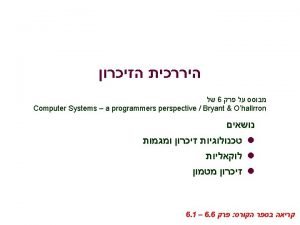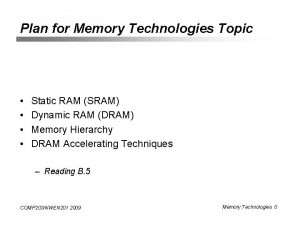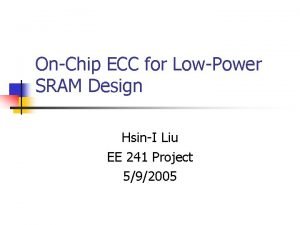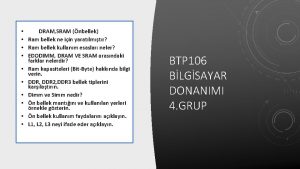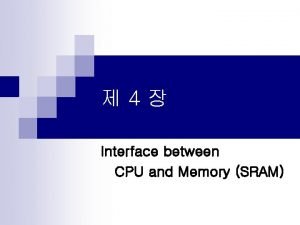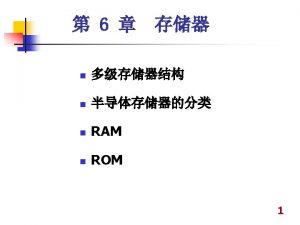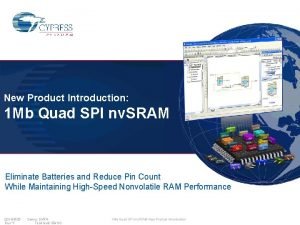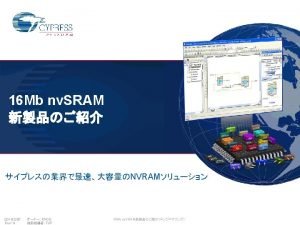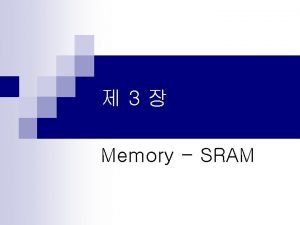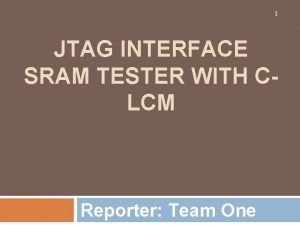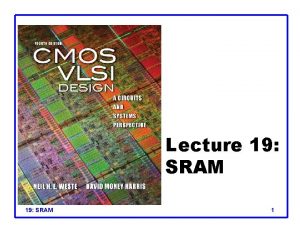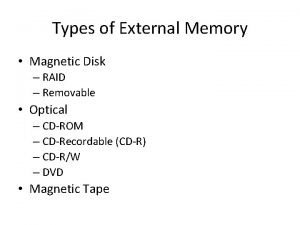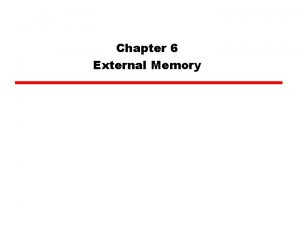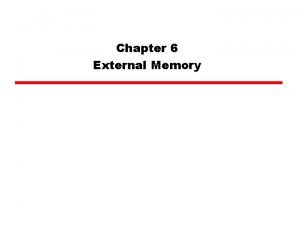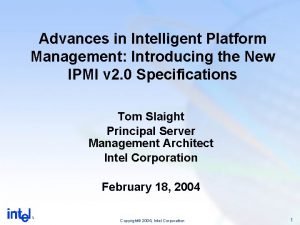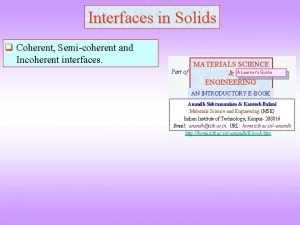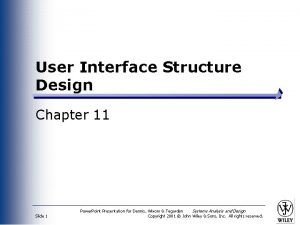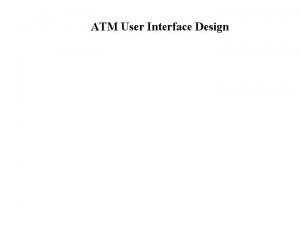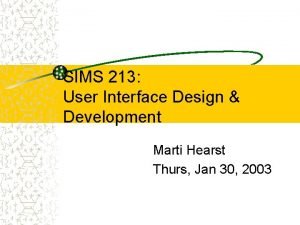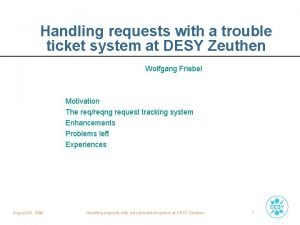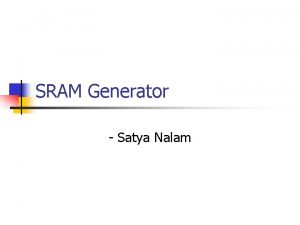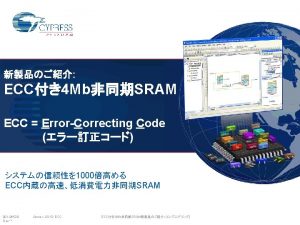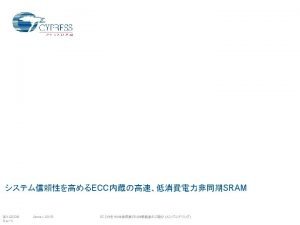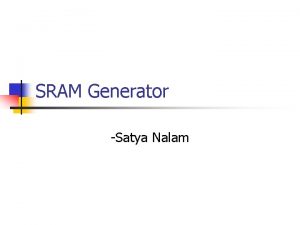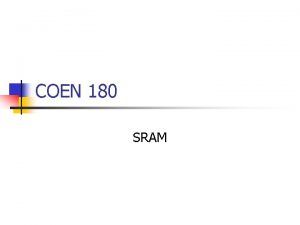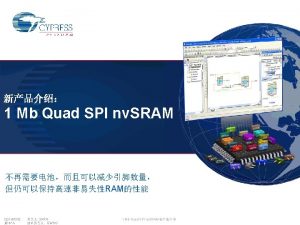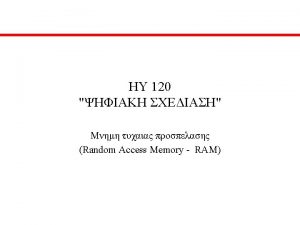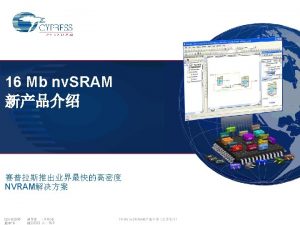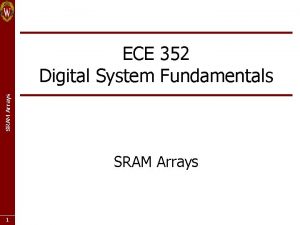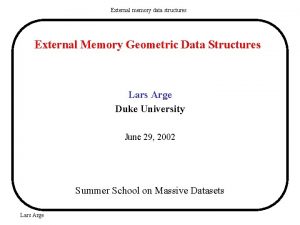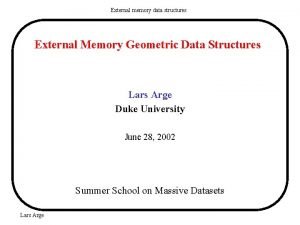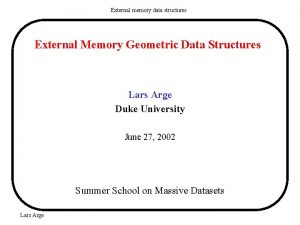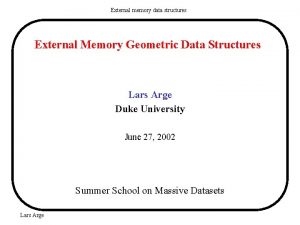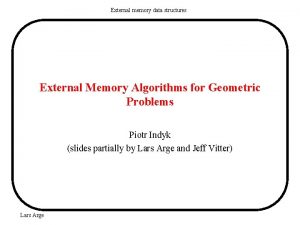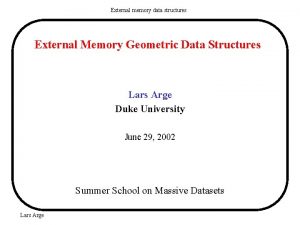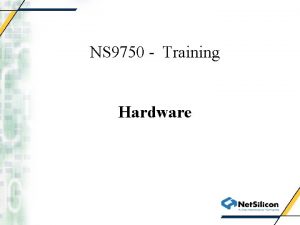SRAM Memory External Interface A 0 A 9


























































- Slides: 58

SRAM Memory External Interface A 0 -A 9 D 0 R/W! E 1 Kbit SRAM GEOMETRY: ( ROWS , COLS ) == ADDRESSES x DATA WIDTH CAPACITY

Making Wider Memories • WANT A 0 -A 9 HAVE D 0 -D 1 A 0 -A 9 R/W! E E 1 Kx 2 bit SRAM D 0 1 Kx 1 bit SRAM

Making Wider Memories A 0 -A 10 A 0 -A 9 D 0 R/W! E R/W! A 0 -A 9 R/W! E E 2 Kx 1 bit SRAM D 0 D 1 D 0 -D 1

Making Taller Memories • WANT A 0 -A 10 HAVE D 0 A 0 -A 9 R/W! E E 2 Kx 1 bit SRAM D 0 1 Kx 1 bit SRAM

Making Taller Memories • WANT A 0 -A 10 HAVE D 0 A 0 -A 9 R/W! E E 2 Kx 1 bit SRAM D 0 1 Kx 1 bit SRAM

Making Taller Memories A 0 -A 10 D 0 A 0 -A 9 R/W! E E 2 Kx 1 bit SRAM D 0 1 Kx 1 bit SRAM

Address Mapping 0 00000 1 K rows 0 11111 1 00000 1 11111 2 K rows

Address Mapping 0 XXXXX 1 K rows 2 K rows A 10 1 XXXXX

Making Taller Memories A 0 -A 9 A 0 -A 10 A 0 -A 9 D 0 R/W! A 10 E R/W! A 0 -A 9 R/W! E E 2 Kx 1 bit SRAM D 0 D 0

Making Taller Memories A 0 -A 11 D 0 A 0 -A 9 R/W! E E 4 Kx 1 bit SRAM D 0 1 Kx 1 bit SRAM

Address Mapping 00 00000 1 K rows 00 11111 01 00000 01 11111 10 00000 10 11111 11 00000 11 11111 4 K rows

Address Mapping 00 XXXXX 1 K rows 01 XXXXX 4 K rows 10 XXXXX 11 XXXXX

Making Taller Memories A 0 -A 11 A 0 -A 9 D 0 R/W! A 11 -A 10 E R/W! A 0 -A 9 D 0 R/W! E E A 0 -A 9 D 0 R/W! E A 0 -A 9 R/W! E D 0 D 0

Where is the decoder? A 0 -A 9 A 0 -A 10 A 0 -A 9 D 0 R/W! A 10 E R/W! A 0 -A 9 R/W! E E 2 Kx 1 bit SRAM D 0 D 0

Memory External Interface A 0 -A 9 D 0 R/W! E 1 Kbit SRAM

SRAM Internal Organization A 0 -A 9 SRAM bit Wire delay = f(length^2) E Decoder R/W! Sense Amp D 0

SRAM Internal Organization A 0 -A 4 A 0 -A 9 s Row Decoder u 32 x 32 array q s s A R/W! A 5 -A 9 Column Mux D 0 E e ar a o p s le sib

Wider Data Bus A 0 -A 4 A 0 -A 9 Row Decoder R/W! A 5 -A 9 E 32 x 32 array Column Mux D 3 D 2 D 1 D 0

Wider Data Bus A 0 -A 4 A 0 -A 9 s Row Decoder u 32 x 32 array q s s A R/W! A 5 -A 9 Column Mux D 0 -D 3 E D 0 -D 3 e ar a o p s le sib


SRAM Bit Cell 6 T Cell bitline! bitline row select bit-cell array 2 n n -Read Sequence 1. precharge all bitlines 2. address decode 3. drive row select 4. selected bit-cells drive bitlines 5. diff. sensing and col. select n+m 2 n row x 2 m-col (n m to minmize overall latency) m 2 m diff pairs sense amp and mux 1 From Prof. Sankaralingam, UWisc-Madison

SRAM Bit Cell - Precharge Vdd bitline! bitline wordline

SRAM Bit Cell – Decode Row and Select bitline! bitline row select

SRAM Bit Cell – Mux and Sense bitline! bitline row select

SRAM Bit Cell – Mux and Sense bitline! bitline row select

SRAM Bit Cell – Writes 0 1 bitline! bitline row select


Memory Array From prof. Gulak’s Slides

Decoders users. ece. utexas. edu/~adnan/vlsi-05 -backup/lec 13 SRAM. ppt

Larger Decoders • For N>4 NAND becomes slow • Use 2 -input gates hierarchically users. ece. utexas. edu/~adnan/vlsi-05 -backup/lec 13 SRAM. ppt

Pre-Decoding • Many gates are redundant – Saves area

Dynamic RAM • _bitline wordline • • RAS bit-cell array 2 n n 2 n row x 2 m-col (n m to minmize overall latency) m CAS 2 m sense amp and mux 1 • Value is stored on a capacitor C – single pass transistor T connects C to the bit line when the cell is being read or written C experiences leakage meaning the charge stored on C will slowly leak out, thus destroying the value To prevent this DRAM cells need to be periodically refreshed – emory controller goes through and reads all the cells and then writes the same values back DRAM cells have a different manufacturing process than processors so it’s difficult and expensive to incorporate them onto the same chip A DRAM die comprises of multiple such arrays From Prof. Sankaralingam, UWisc-Madison

_bitline wordline From http: //en. wikipedia. org/wiki/File: DRAM_trench_structure_configuration 1_1. svg

DRAM Notes • Read: – Bit line is pre-charged and then word line is activated. If there is a 1 in the capacitor, then the bit line remains high. Otherwise it gets pulled down • Write: – Bit line is driven to the write value and either charges or drains the capacitor writing the value into it. • Refresh adds overhead: – Usually each cell has to be refreshed every 64 ms – Cell is unavailable for 2 -4% of refresh period (i. e. 1. 2 to 2. 4 ms of each 64 ms period) – Memory controller tries to schedule refreshes so they don’t interfere with regular memory traffic – Self-Refreshing memories

Synchronous DRAM http: //search. library. utoronto. ca/details? 6949501 Memory Systems Cache, DRAM, Disk About this Book Author(s): Bruce Jacob, Spencer W. Ng, David T. Wang and Samuel Rodriguez

Synchronous DRAM (SDRAM) RAS’ Column Row Data BURST From Prof. Sankaralingam, UWisc-Madison

DDR 2 (Double Data Rate RAS’ Column Row Data From Prof. Sankaralingam, UWisc-Madison

Addressing in Modern DRAM

DRAM Organization Alternatives • 128 MB DRAM Capacity • 64 -bit data bus – 1 Gbit capacity • 64 MBit w/ 4 -bit data bus? • 64 Mbit w/ 8 -bit data bus? • 128 Mbit w/ 16 -bit data bus?

DRAM Organization Alternatives • 128 MB DRAM Capacity • 64 -bit data bus – 1 Gbit capacity • 64 MBit w/ 4 -bit data bus? – 64 bit bus? 16 devices – 16 x 64 Mb = 1 Gbit • 64 Mbit w/ 8 -bit data bus? – 64 -bit bus? 8 devices – Capacity? 8 x 64 Mbit = 512 Mbit 2 ranks • 128 Mbit w/ 16 -bit data bus? – 64 -bit bus? 4 devices – 1 Gbit capacity

• Home > Computer Hardware > Memory > Desktop Memory > Mushkin Enhanced > Item#: N 82 E 16820146744 • • • Mushkin Enhanced Essentials 2 GB 240 -Pin DDR 3 SDRAM DDR 3 1333 (PC 3 10666) Desktop Memory Model 991586 • DDR 3 1333 (PC 3 10666) • Timing 9 -9 -9 -24 • Cas Latency 9 • Voltage 1. 5 V

DDR 3 1333 • Operates at 667 Mhz • Can tranfer data at double the rate – Bandwidth 1333 MT/sec • Mega transfers per second

DRAM Access Sequence • • • 1. Precharge 2. Row Access 3. Column Access 4. Data Transfer 5. Close Row (write data back)

DRAM Timing • t. CAS-t. RCD-t. RP-t. RAS • t. CAS: column address strobe column to data appearing • t. RCD: – RAS to CAS row to column • t. RP: – RAS precharge, Precharge latency • t. RAS: – Row Access Strobe: Shortest time between two Row activations

DDR 3 Timing • Timing 9 -9 -9 -24 • t. CAS-t. RCD-t. RP-t. RAS

DDR DRAM Timing 9 -9 -9 -24 t. CAS-t. RCD-t. RP-t. RAS From anandtech: http: //images. anandtech. com/doci/3851/Back%20 to%20 Back%20 Burst%20 Read%20 with%20 Page%20 Close. png

Interleaved Main Memory • Divide memory into M banks and “interleave” addresses across them, so word A is – in bank (A mod M) – at word (A div M) Bank 0 Bank 1 word 0 word n word 2 n word 1 word n+1 word 2 n+1 Bank 2 Bank n word 2 word n+2 word 2 n+2 word n-1 word 2 n-1 word 3 n-1 PA Doubleword in bank Bank Word in doubleword Interleaved memory increases memory BW without wider bus • Use parallelism in memory banks to hide memory latency Copyright © 2002 Falsafi, from Hill, Smith, Sohi, Vijaykumar, and Wood 47



Flash Memory gate Floating gate n n p

Flash Memory “ 1” “ 0” - ------ - --- n n p n Trapped charge n p • Floating gate changes threshold voltage • SLC 2 states • MLC more states

Flash Memory -- Reading gate Voltage Floating gate n n p

Flash Memory – Writing a “ 0” gate High Possitive Voltage ------ ---n n p

Flash Memory – Writing a “ 1” gate High negative Voltage n n p

NAND FLASH

NAND FLASH Reading Conduct no matter what value Conduct only if no charge Von Von VA Von Von Von

NAND FLASH Erasing Clear off all charge: negative Von Ve Ve Von

NAND FLASH Writing Conduct no matter what value High possitive Von Von VA Von Von Von
 Internal memory and external memory
Internal memory and external memory Scolarité insuffisante sram
Scolarité insuffisante sram Scolarité insuffisante sram
Scolarité insuffisante sram Sram vs dram
Sram vs dram Scolarité insuffisante sram
Scolarité insuffisante sram Sram vmin
Sram vmin Vlsi
Vlsi Example of sram
Example of sram Sram
Sram Sram nedir
Sram nedir Cpu sram
Cpu sram 2114 sram
2114 sram Qspi sram
Qspi sram Sram spi
Sram spi Sram john abbott
Sram john abbott Sram
Sram Sram address
Sram address Jtag waveform
Jtag waveform Sram column mux
Sram column mux Hierarquia cambio sram
Hierarquia cambio sram What is interface in java
What is interface in java User led through interaction via series of questions
User led through interaction via series of questions Office interface vs industrial interface
Office interface vs industrial interface Interface------------ an interface *
Interface------------ an interface * External-external trips
External-external trips Types of magnetic disks
Types of magnetic disks External memory types
External memory types Types of external memory
Types of external memory Shared vs distributed memory
Shared vs distributed memory Long term memory vs short term memory
Long term memory vs short term memory Virtual memory and cache memory
Virtual memory and cache memory Rocky slowly got up from the mat
Rocky slowly got up from the mat Primary memory and secondary memory
Primary memory and secondary memory Virtual memory in memory hierarchy consists of
Virtual memory in memory hierarchy consists of Explicit memory
Explicit memory Logical memory vs physical memory
Logical memory vs physical memory Eidetic memory vs iconic memory
Eidetic memory vs iconic memory Which memory is the actual working memory?
Which memory is the actual working memory? Web based interface
Web based interface Cigi interface
Cigi interface Intelligent platform management interface market demand
Intelligent platform management interface market demand Cash register interface
Cash register interface Netflix activity diagram
Netflix activity diagram Apa pengertian antarmuka pemakai (user interface)
Apa pengertian antarmuka pemakai (user interface) Coherent thought
Coherent thought User interface structure
User interface structure Atm interface design
Atm interface design Interface hall of shame
Interface hall of shame Idscenter
Idscenter Jedmayer wien
Jedmayer wien Gui lab
Gui lab Bo tu network
Bo tu network Interface uco
Interface uco Windows 7 user interface
Windows 7 user interface Command line logo
Command line logo Design pyramid for webapps
Design pyramid for webapps Confirmtx
Confirmtx Characteristics of the graphical user interface
Characteristics of the graphical user interface Open fabric interface
Open fabric interface



